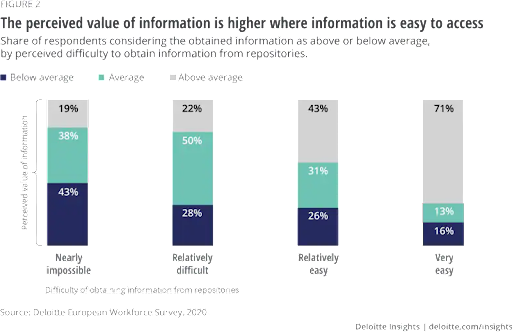
Knowledge is a strategic asset that shapes every decision and strategy a business undertakes in its lifetime.
When managed well, knowledge can bring astounding results in the form of increased productivity, team collaboration, and innovation. On the contrary, inadequate knowledge management can jeopardize your growth.
A well-defined knowledge management process is all you need to effectively capture, manage, share, and utilize business knowledge. This process brings all your employees to a centralized platform and encourages them to share their unique skills and insights.
With all business knowledge under a single roof, employees can collaborate, innovate, and work together towards their business goals.
This blog sheds light on the process of knowledge management, its objectives, stages, and much more. Dive in to uncover the incredible power that business knowledge holds.
Let’s go!
What Is a Knowledge Management Process?
Knowledge management process is a procedure of capturing, storing, and sharing knowledge in your organization. This process also takes care of the accuracy and security of the knowledge bring captured. Effective knowledge management improves communication between departments and boosts decision-making and collaboration. Furthermore, with employees having access to useful insights, they can be more innovative and experimental with their work.
Read More: Top 15 Knowledge Base Software and Tools
Why Is Knowledge Management Process Important?
A knowledge management process is instrumental in addressing the constant knowledge requirements of employees within your organization. It is an important process wherein you address various organizational inefficiencies related to knowledge sharing, employee onboarding, and poor productivity. This is achieved by consolidating all business information on a centralized platform that is easy to access and use.
Another important reason is the fact that the perceived value of information is directly related to its ease of access. A survey carried out by Deloitte revealed that 71% of employees perceive the value of information as above average if it is easy to access.

This ease of access can be achieved if you have a full-fledged and well-defined knowledge management process in place. The easier it is for employees to get the information they need, the better they will be able to collaborate and innovate.
Key Objectives of Knowledge Management Process
A well-defined knowledge management process can bolster learning, collaboration, and productivity. These are some of the knowledge management process objectives you need to keep in mind during its implementation.
Let’s explore these objectives in detail here.
Promote Uninterrupted Learning
The right knowledge management process provides your employees with round-the-clock access to critical company information. This process allows them to continue learning without relying too much on training sessions. Your employees become independent learners as they can learn at their own pace simply by accessing your knowledge management platform.
The systematic, easy, and on-demand approach to knowledge management improves information flow and helps your employees work more efficiently.
Boost Employee Productivity
Scrambling for information spread across files and folders is a productivity killer. At a time when employees should be focusing on the task at hand, they are busy scrolling through documents. A knowledge management process helps you create a single source of truth that employees can access anytime they need. This saves a major chunk of their time that they can use in their daily tasks and be more productive.
Speed-Up Employee Onboarding
New hires require guidance right from the beginning. A simple office tour cannot complete the task of familiarizing them with your company, people, and work culture. The systematic process of knowledge management can greatly help with employee onboarding. New hires can independently learn everything about their new roles and responsibilities and get up to speed faster.
Improve Team Collaboration & Innovation
Implementing a knowledge management system improves team collaboration by allowing employees to share their ideas, insights, and experiences on a centralized platform. Employees can work cohesively to build and maintain your company’s knowledge, enhancing their learning in the process. This also helps them think innovatively while working on projects.
Enhance Decision-Making
Lack of access to business knowledge can lead to poor decisions. With a knowledge management process in place, your employees can instantly access the information they need to analyze problems or situations and make informed decisions. Every time employees are in the middle of a project, stuck in a problem, or facing a challenge, a knowledge management system helps them take the right steps.
Read More: 15 Hot Knowledge Management Trends
Stages of the Knowledge Management Process
There are a total of 6 knowledge management process stages that should be implemented correctly to achieve the desired results. Let’s look at each one of them in detail here.
Discovery
According to a global survey of 1300 IT professionals and businesses, 55% of all business data goes unused.
What can be the reason behind this? Often, data goes unused when it is hidden in files and difficult to access. This is exactly what the first stage of knowledge management focuses on – the discovery of information.
Knowledge discovery refers to extracting information from all relevant sources and business assets. The process involves identifying which data can be helpful and can add value to different aspects of your business. This task may seem easy at first, but extracting useful information from loads of scattered company data can be time-consuming. After all, not every piece of information is a knowledge asset.
Creation or Capture
Once you have identified and pinpointed knowledge assets, you need to execute the next stage of knowledge management, i.e., knowledge creation or capture.
Bring all the necessary information to a centralized platform where it can be managed and structured. In case there are gaps in the existing documents, try creating new content to fill that gap.
You can start by importing data from Word docs, Excel sheets, and Powerpoint presentations. For data, you need to create from scratch, talk to the department heads and understand the topics that should be covered. This will give you a good starting point and prevent redundancies.
Structuring
The third stage of the process is all about lending a good structure to the information captured.
In this stage, you need to categorize and structure the content to ensure smooth navigation and retrieval. You can start by creating a table of contents and adding broad topics as categories. Identify sub-topics that can be added to each category.
Once you are done with the structure, segment the collected information into different categories. Besides segmentation, you also need to focus on how the content is presented in each article.
Are the paragraphs and headings short and simple?
Do the articles have bullet points to make content consumption easier?
Is the language easy to understand?
Is there enough interlinking to switch between articles?
These are some of the things that must be considered when structuring the content of your knowledge management system.
Assessment
Once you are done with the capturing and structuring of content, the next step is to evaluate and improve its quality.
You can set up a review process wherein your top contributors or reviewers carefully scan each article to filter out irrelevant content, validate facts, and ensure that the information is up to date.
Outdated information, conflicting articles, and knowledge gaps are some of the commonly found issues that should be addressed in the assessment stage.
Modern knowledge management tools come with a workflow review system and assessment software that helps you set a status for all articles depending on their stage. This streamlines the review process as every article is under scrutiny and is thoroughly reviewed before it goes for publishing.
Distribution
Once your knowledge base is reviewed and ready to be shared, the next step is to work on its distribution. Here are a few things you should keep in mind while working on this stage of the knowledge management process.
- Accessibility: Your knowledge management system should be easy to use and access. It should provide seamless access across devices so that employees can learn on the go. Inadequate accessibility might push employees back to the old methods of finding information which will defeat the purpose of the knowledge management process.
- Access permissions: Define the roles and access levels of each employee and exercise full control over who can do what in your knowledge management system. You can give edit rights only to top management and contribution/view rights to everyone in the organization.
- Security: Security is another area you should focus on. You can set conditions to restrict access to folders with sensitive content and avoid any security breaches. Additionally, investing in a VPN could provide an extra layer of protection for your data. It ensures encrypted connections and anonymous browsing, enhancing your overall cybersecurity compliance.
- Maintenance: Ensure you have a maintenance process in place that utilizes usage reports and feedback to address gaps and knowledge discrepancies.
Taking care of the above-mentioned points will ensure employees always have easy access to updated business information.
Optimization
Optimizing your knowledge base the right way helps improve the user experience and content quality. You need to pay close attention to optimizing its four pillars:
- User experience – To deliver a delightful user experience, your knowledge management system needs to be fast, easily accessible, and optimized for desktop and mobile browsers.
- Search: Optimizing your knowledge base content with the relevant keywords ensures blazing-fast search results. Furthermore, the content should be neatly structured for the search results to be accurate.
- Content: Content is the backbone of a knowledge management system. The more clear, organized, and easy to read your content is, the easier it would be for employees to consume the information.
- Structure: Optimizing the structure of your knowledge management system includes breaking down your content categories into subcategories for easier navigation. Avoid long paragraphs and add bullets wherever possible.
Modern tools like ProProfs Knowledge Base help organizations implement the stages of the knowledge management process. It has all the required features that can aid the execution of all stages without any hassles.
Implement Knowledge Management to Boost Your Business Growth
A systematic process of knowledge management is essential for organizations to maintain a steady flow of information, and improve team learning and collaboration. It equips your employees with the right knowledge and greatly increases workforce productivity.
Efficiently managing knowledge gives you an edge over your competition. To make the most of this knowledge, you need to follow a well-defined process, including all necessary stages from the discovery of information to its distribution and optimization.
For this process to be successful, it’s crucial to employ strong knowledge management software that can support you at every stage. The right tool will make sure all business information is structured, assessed, and disseminated optimally.
FREE. All Features. FOREVER!
Try our Forever FREE account with all premium features!







